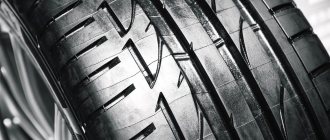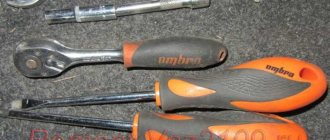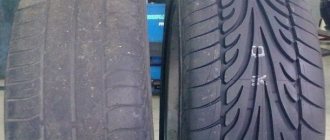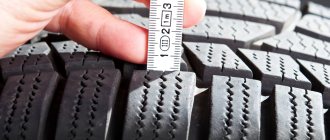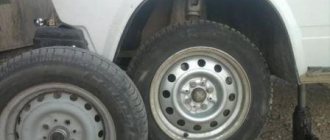The choice of protectors determines the controllability of the vehicle, the duration of its operation, stability and quality of traction. Therefore, before moving on to installation, you need to understand what kind of tires you need to buy, what consequences await you if installed incorrectly, and how not to get into trouble. In the article we will talk about directional tires and look at: what they are, how to install tires correctly, choose rubber with an arrow pattern (and without it) on the tread, we will talk about ways to install wheels with a choice of direction.
Installation
Installing Bridgestone asymmetric tires does not require highly skilled skills if you remember a few instructions. The inscriptions “Inside” and “Outside” must be strictly established according to the rules.
Directional tires must be installed so that when driving, the wheel moves in the direction indicated by the arrow. When installing, you need to focus on moving forward.
Symmetrical (non-directional) tires are installed at the discretion of the owner. Therefore, they do not have any instructions for installation.
Important: if at least one wheel is installed incorrectly, then vehicle control will deteriorate sharply, and the tires will quickly become unusable!
Installation is best done as follows:
- Loosen the mounting bolts. To raise
car, you need a jack and a flat surface. After which the old wheels are removed and new wheels are installed.
To avoid confusion during the installation process, it is recommended to change one tire at a time. It is better to immediately install new tires in place of old ones. When installing, you must strictly follow the instructions and monitor the direction of the new tires. Competent and correct installation ensures that the vehicle's driving performance will be excellent, and you will not have to buy new tires every month.
Proper installation of summer, winter or all-season tires guarantees that the tires will maximize their driving performance, and car owners will be able to feel comfortable and safe at any time of the year, and on any road surface.
Source kolesnyigid.ru
I think any motorist who changed his own wheels for the first time had the following question: “Which wheel should I put where?” Of course, I won’t tell experienced drivers anything new, but many beginners read me and I think this information will be interesting for them. This is what today’s article will be about, especially since it is more relevant than ever, because... The time for “re-shoeing” has already begun.
Right or left?
This is the most common question among those drivers who are changing tires for the first time. In general, to answer this question you just need to look carefully at your “tires” - everything is written on it. The main thing is to understand the markings and understand what type of tires you have.
So, 3 types of tires are now widely used:
- Non-directional
- Directed
- Asymmetrical
How do you know what type you have?
So, the most basic way is to just look carefully at the sidewalls of the tires.
- If the tires have the inscription “Ins>That is, as you understand, you just need to carefully examine the tires - everything is written on them. No special knowledge required.
Now let's figure out which axle to put the wheels on - forward or backward?
In general, there is nothing complicated here either. There are two cases: when you have new tires and when you have used ones. If the tires are new, then in fact there is no difference where you put the wheels (forward or backward) - i.e., you can put them anywhere. And by the way, in order for new tires to wear more evenly, it is recommended to rearrange the wheels between axles every season.
But if the tires are already used, then it is customary to install on the front axle those wheels whose tires are less worn. Those. We put better tires in front and worse tires in back. This is due to the fact that the tires on the front wheels wear more heavily.
Source avtoidei.ru
How to correctly determine the direction of the tire?
If the direction of rotation is not indicated, this means that the tread mark of this tire is symmetrical. This tire can be placed on either side. For this type of tire, it doesn’t matter how it is installed.
If you couldn’t find the arrow on the tire indicating the direction of rotation of the wheel, then you’re in luck!) This tire can be installed in any way, the tread pattern works when rotating in both directions.
Usually this pattern occurs on summer tires. But winter tires require strict installation in the direction.
Source www.bolshoyvopros.ru
Replacement scheme
Previously, it was believed that wheels had to be installed in a certain order. That is, during the season there should be one arrangement, and at the next “change of shoes” - another. All this had one goal - to ensure uniform wear on all elements of the kit. Now this remains relevant only for non-directional asymmetrical models, which can be placed in any way. Let's look at an image with an approximate shift diagram:
Please note: with correct wheel alignment, tire wear will occur evenly, and the indicated diagram will not be useful to you.
Tire seasonality
Typically, the tire is marked with information about the season and/or weather conditions for which the tire is intended. Here is what some inscriptions (icons) mean, indicating the seasonal specialization of the tire:
M+S
(
M&S
) –
lugs
.
This inscription in no way means that the tire is winter
, although it stands for Mud and Snow.
In fact, such an abbreviation only means that the tire tread is intended for driving off asphalt, or on asphalt with mud and snow porridge. Such an inscription on the tire says absolutely nothing about the chemical composition of the tire (and this is precisely the main difference between winter tires and summer tires). The M&S marking is applied to winter, all-season and off-road summer tires
.
AS
(All Season),
Any Season
,
All Season
,
R+W
(Road + Winter),
AW
(Any Weather),
AGT
(All Grip Traction) -
options for designating all-season tires
. We remind you that all-season tires are absolutely not intended for use in severe frosts and/or warm weather - only at near-zero temperatures.
Rain
,
Aqua
,
Water
,
Aquatred
,
Aquacontact
, or
a painted umbrella
mean that the tire provides improved water drainage from the contact patch with the road and, accordingly, reduced aquaplaning characteristics - the so-called
rain tires
.
Snowflake painted on the side of a tire
, or the inscription
Winter
indicate
winter tires
.
Asymmetric tires, advantages and disadvantages
Tire manufacturers have developed asymmetric tires. Design features, as well as the tread pattern, provide this type of tire with good wheel grip on the road surface. Our article describes the advantages and disadvantages of such tires and indicates the features of its installation.
Design features
Different types of tread patterns The term asymmetrical tires must be understood as tires that differ in the direction of the pattern on the outer as well as the inner side of the treadmill. The first company to introduce the production of this type of rubber was the well-known Nokian brand, which produced tires with a directional tread pattern. Features of these tires:
- You can install tires in accordance with the direction of the arrow or the inscription “ROTATION” on the side of the tire;
- Tires are divided into left and right, marked respectively with the letters L or R.
When installing directional asymmetrical rubber, the following difficulties arose:
- It was almost impossible to install two wheels with left markings or two products with right markings, since tires with left and right markings were rarely available in one car shop.
- Determining the type of tire for a spare tire is quite difficult: it is impossible to know in advance which wheel will require replacement. In force majeure situations, drivers installed the spare wheel on the wrong side, which led to accelerated wear of the tread layer.
Tire manufacturers decided to abandon the production of asymmetric tires with a directional pattern. They were replaced by similar rubber with a non-directional tread pattern.
Non-directional asymmetric tires can be identified by the following characteristics:
- In this type of rubber, the inner side is softer than the outer. This allows you to correctly distribute the load when the car enters a turn: most of the load falls on the outer part of the product.
- The tread blocks on the outside of the tire are larger than on the inside. This design of the tread layer allows for better drainage of fluid from the grip patch of the wheels and the road surface. This reduces the risk of hydroplaning and makes driving easier.
- Car tires are installed on the left and right sides.
On symmetrical tires there is no marking on the outer and inner sides; by this feature it is easy to distinguish symmetrical tires from asymmetrical products.
We recommend watching a video about directional and asymmetrical tires:
Advantages and disadvantages, installation features
Advantages of tires with an asymmetric tread layer:
Disadvantages: significant disadvantages were present in asymmetric tires with a directional tread pattern, but this type of tire has been discontinued.
Installation of rubber with an asymmetrical tread pattern is carried out taking into account the outer and inner sides of the product. You can find out which side to mount the tires by looking at the corresponding inscription on the side of the tire. Their outer side has one of the designations:
- outside;
- side facing forwards;
- external.
The inside of the tire has one of the markings:
- this side facing inwards;
- inside.
When installing such tires, the direction of the tread pattern does not matter. Correct installation involves placing tires depending on the outside and inside of the tire.
Conclusion
Asymmetric tires are often confused with directional tires - this causes difficulties in installing these products on a car. We have indicated the distinctive characteristics and design features of tires with an asymmetrical tread pattern, which must be taken into account when purchasing and installing this type of rubber.
Purchasing tires with an asymmetric tread pattern is important when purchasing expensive tires; such a tread pattern ensures a long service life of the rubber.
pro-zamenu.ru
How to correctly install tires on a rim according to the marks
When buying tires, many drivers pay attention to the multi-colored markings on the sidewalls. The paint wears off quickly in the first weeks of use, but it can help with tire fitting. What color is it and what does it mean:
- Yellow. It indicates the easiest place, usually located opposite the air injection nipple valve. This simple mark makes the balancing system easier.
- Red. This, on the contrary, is the hardest point of the wheel. It should be where "L" is indicated on the disk.
- White. This is the most flexible part. The designation is necessary for car manufacturers and assemblers.
All tire fitters are familiar with the different color markings and can help you decipher them.
Video
See below for more information about the operating features of tire tread patterns:
It will be easier to decide on a tread pattern when purchasing new tires if you know their advantages and disadvantages, operating and installation features.
Tire with symmetric tread
As the name suggests, its tread consists of two halves with the same symmetrical pattern. The symmetrical tread provides fairly good vehicle stability on the road and demonstrates moderate efficiency in removing water from the contact patch between the wheel and the road surface.
These tires are low noise and durable. Due to the lack of direction for installation, they can be replaced and installed on any wheel of the car.
Tires with symmetrical tread belong to the middle and low price category, are intended for city cars and are universal in terms of operating conditions.
Asymmetrical tire
Its main difference from the symmetrical one is the difference in the tread pattern of the outer and inner sides of the tire.
Dense and rigid elements of the outer side of the tread ensure directional stability of the car when turning, providing it with high maneuverability, and wide drainage channels on the inner side successfully remove water and moisture from the contact patch, reducing the probability to almost zero.
To ensure correct tire installation, the outer side of the tread is marked “Out Side” and the inner side is marked “In Side”. If the tire is installed incorrectly on the wheel rim, the vehicle's handling will noticeably decrease, and the tires themselves will wear out quite quickly. There are no restrictions on changing the location of wheels with asymmetrical tires.
Tires with an asymmetric tread pattern are an improved version of classic symmetrical tires and are excellent for use in any road conditions. Naturally, their cost is noticeably higher than that of tires with a symmetrical pattern. Designed for middle and premium class cars.
Directional tread pattern
What distinguishes car tires with a directional pattern from other tires is the configuration of the drainage channels, reminiscent of the Latin letter “V”.
In addition to effectively draining water from under the wheels, such tires provide reliable traction when driving on snow and. Rubber with a directional tread pattern is an excellent choice when driving on wet and wet roads.
Among the disadvantages, it should be noted the high noise level of wheels with a herringbone pattern compared to classic and asymmetrical tires.
When installing tires with a directional pattern, it is necessary to observe the direction of rotation of the wheel, checking the arrow marked on its sidewall. Due to the fact that installing the right wheel on the left axle, and vice versa, is not permissible due to the characteristics of the tread pattern, it is preferable to have a tire with a symmetrical pattern as a spare wheel.
Tires with a directional tread pattern are the most expensive; they are mainly equipped with sports cars and SUVs.
Remember that no matter what shoes you put on your iron horse, you shouldn’t relax, allowing yourself to make gross mistakes while driving in the hope that expensive and especially functional tires will “get you out” of any difficult situation.
- not a decorative element, but a complex system of notches that improves the grip of the wheels on the road surface. The biggest influence on traction is the tire's ability to move water, dirt or snow away from the contact patch with the road. The tread pattern determines the car's cornering stability, braking distance, noise level in the cabin, fuel consumption and maximum safe speed.
The noise from tires with an incorrectly selected pattern, superimposed on the general background noise in the cabin, can provoke a heart attack.
RECOMMENDATIONS
Some general guidelines may be helpful when selecting and using tires. • Use tire sizes recommended in the vehicle's owner's manual. • Since there are no ideal tires, when choosing them it is advisable to determine for yourself which properties, in addition to reliable grip, are most important - “sportiness”, comfort, efficiency, etc. • A tire for comfortable highway driving, while having low noise and good ride comfort, may not provide good stability and controllability at high speeds. • The tire has an increased service life and provides reduced fuel consumption (compared to other models) due to low rolling resistance, but may not provide good comfort. • As a rule, manufacturers indicate in advertising brochures what exactly the best properties a given tire model has, but at the same time they are silent about what properties they “sacrificed” for this. • By selecting tire parameters when replacing them, you can improve some vehicle performance, but certainly at the expense of others. • Low profile tires will improve vehicle handling, especially at high speeds, but they are more susceptible to damage on rough roads. • Only external similarities or, conversely, differences between tires from different manufacturers do not allow us to draw an unambiguous conclusion about the similarity or difference in their performance properties. • All tires, even within the same type, vary in rubber chemistry, internal construction and tread pattern. • The use of winter tires in the summer, in addition to their accelerated wear, worsens the directional stability, handling ("cotton steering wheel") and braking properties of the car.
Inner and outer side of the tire
Markings on the outside or inside of the tire are extremely important in order to install the tires correctly. Therefore, let us briefly summarize the material presented above:
The most universal is non-directional symmetrical rubber, which can be placed in any place without removing it from the disk; directional - no. Therefore, it is worth having a spare tire with such a tread - this will make the situation easier when necessary; outside markings, like inside marks on tires (translation: outer or inner side), indicate an asymmetrical tread pattern. The inscriptions are printed on the sides of the product. These wheels have two different tire sections for dry or wet pavement; asymmetrical rubber provides more confident grip on the road, excellent drainage, maximum contact patch
However, such tires cannot be swapped relative to the left or right side of the car; the cost of such sets is 10-15% higher than similar tires with a standard pattern; When installing asymmetrical sets or tires with a directional pattern, the tread pattern and the direction of wheel movement should be taken into account. You can learn more about all the tricks of tire fitting from professional videos.
PROMOTION: SALE OF NEW CAR 2022 PRODUCTION
Source daciaclubmd.ru
I think any motorist who changed his own wheels for the first time had the following question: “Which wheel should I put where?” Of course, I won’t tell experienced drivers anything new, but many beginners read me and I think this information will be interesting for them. This is what today’s article will be about, especially since it is more relevant than ever, because... The time for “re-shoeing” has already begun.
Right or left?
This is the most common question among those drivers who are changing tires for the first time. In general, to answer this question you just need to look carefully at your “tires” - everything is written on it. The main thing is to understand the markings and understand what type of tires you have.
So, 3 types of tires are now widely used:
- Non-directional
- Directed
- Asymmetrical
How do you know what type you have?
So, the most basic way is to just look carefully at the sidewalls of the tires.
- If the tires have the inscription “Ins>That is, as you understand, you just need to carefully examine the tires - everything is written on them. No special knowledge required.
Now let's figure out which axle to put the wheels on - forward or backward?
In general, there is nothing complicated here either. There are two cases: when you have new tires and when you have used ones. If the tires are new, then in fact there is no difference where you put the wheels (forward or backward) - i.e., you can put them anywhere. And by the way, in order for new tires to wear more evenly, it is recommended to rearrange the wheels between axles every season.
But if the tires are already used, then it is customary to install on the front axle those wheels whose tires are less worn. Those. We put better tires in front and worse tires in back. This is due to the fact that the tires on the front wheels wear more heavily.
Source avtoidei.ru
Advice.
If you encounter difficulties in determining the direction of tire rotation, do not hesitate to consult specialists who will help you understand all the nuances and also provide more accurate information on this issue.
Approach the issue of installing tires competently and wisely, because your safety depends on it!
The modern tire industry is creating its products better and better. Universal products are able to feel great on dry asphalt, drain water, provide traction, and in addition, provide acoustic comfort and reduce fuel consumption.
For modern cars, many sets are offered with a variety of treads and mixture compositions. This versatility has one drawback. The tread pattern differs between the halves of the tire. Therefore, there are Rotation, Inside or Outside marks on the tires, indicating the correct direction of rotation.
In this article we will talk about marking the direction of tire rotation, types of rubber, directional and non-directional tread patterns, and also tell you about all the pros and cons of such products.
What is an asymmetric tread pattern?
Tires belonging to this type have recently been increasingly used by automakers for installation on vehicles of a more expensive class. This is due to the fact that a car equipped with tires with such a pattern will, at a minimum, not lose the high performance characteristics laid down by the manufacturer, and, at a maximum, will increase them.
When answering the question of what an asymmetrical tread pattern means, you should distinguish this type from symmetrical tires. If you look at the rubber relative to the center line drawn along the middle of the wheel along the circumference, you will find that each half has a different pattern than the opposite.
Tire manufacturers offer both winter and summer versions of tires. Each type uses its own compound composition and pattern. They also differ in tread height (for summer tires it is smaller) and the ability to install studs (for winter tires).
Rotation
Some tires (for example, Bridgestone) can be swapped. This is done only crosswise. This means that it is possible to drive 45-60 thousand kilometers, and after that change the location of the wheels. It is possible to put a front left one in place of the right rear one, and a front right one in place of the left rear one. This can be done with the front wheels, but in a strictly defined order.
If the direction of tire movement is specified, the wheels are rearranged on one side, i.e. Front tires are swapped for rear tires and vice versa.
When the tires are symmetrical, it is possible to change the arrangement in any order.
Design Features
The structural features of rubber are distinctive features that increase the driving characteristics of the vehicle.
It is important to understand them for the correct choice of replacement tires
Tubeless, in case of a puncture they retain elasticity for a long time. The rubber tightens around the stuck object. Does not overheat when moving, due to heat removal by the open (metal) part of the rim. In contrast to the tube type, there are increased requirements for the rims, the need to apply additional sealant at the junction of the rim and rubber, and the complexity of installation. Tubeless ones are used more often; if mounted correctly, they have high wear resistance.
The difference between bias-ply and radial tires can only be correctly determined by the markings. Radial - r. Diagonal - do not have a letter index. You can understand the markings of diagonal ones by the presence of the TT designation - operation with a camera. Those who value speed need to understand the differences.
The tread on the tires provides traction. You can determine by the tread:
- seasonal purpose of rubber - for example, it is correct to install tires with metal studs for the winter in a climate zone with frequent thaws and ice;
- in which direction should the tire move (if there are no markings on the rubber, you can determine the side with an asymmetrical pattern by its rigidity - the outer side is stiffer, the correct way to install the tires).
The tread pattern on asymmetrical ones is larger on the outside. Do not purchase with even the slightest difference in the pattern - tires rotate with minimal lag - uneven grip on the road surface
Especially important for highways and sharp descents
Viatti Brina Nordico
The combination of advanced technology and high-quality rubber alloy guarantees the asymmetrical tire excellent performance and durability.
The model is distinguished by reinforced blocks on the outside, which is confirmed by the inscription Outside. At the same time, the direction of the spikes is also visible - upon careful examination, the central part of the working surface is elongated in the direction of movement of the machine.
The whole truth about the Viatti tire brand
I did a little research and found out that tires are indeed produced in the petrochemical complex of the OJSC Tatneft holding. Previously, tires for new passenger cars from the AvtoVAZ and GAZ plants were produced there. In July 2002, a management company was created, and the plant came under the control of this company. The plant received its next round of development in 2005. Then an agreement was reached between the OJSC Tatneft holding and the famous German tire brand Continental to launch a new tire production. A German named Wolfgang Holzbach played a significant role here, then he worked for the Continental brand as vice president for the development of international business projects of the company.
Thus, Wolfgang Holzbach began work as deputy director of Management Company Tatneft-Neftekhim LLC, he is involved in monitoring production and increasing the efficiency of people. Under his leadership, the plant started up almost from scratch. In one of his interviews, he convinces that the plant in Tatarstan is modern and uses high-quality technologies. And employees undergo advanced training, including at the Continental base in Germany. The plant's products are intended for trucks and buses and are supplied within Russia and to European countries.
It’s not for nothing that I talk a lot about this German here. The Viatti brand appeared thanks to him. They write that he had long dreamed of creating a new tire brand. The man said it, the man did it! There are very few details here; on the Internet they write about the same thing everywhere. They decided to position the Viatti brand as a premium class. The design was ordered from Italian craftsmen related to the Pirelli brand, and production was established at a new site in Nizhnekamsk. The Viatti tire production line is entirely made of German equipment, production automation is almost 100%. The result was Italian-German-Russian tires. But adapted to Russian roads and climate. The Viatti model range includes winter non-studded (Brina, Vettore Inverno), winter studded (Brina Nordico and Bosco Nordico), all-season (Bosco A/T) and summer tires (Strada Asimmetrico).
Russian consumers may have noticed tires of this brand, for example, on the new Skoda Octavia sold at official dealers. And this means recognition of the quality of the tires, because Volkswagen will not install bad ones on the cars of its holding company. Meticulous automotive journalists tested some tire models. Their skeptical general conclusion is that Viatti tires are unlikely to be installed en masse on premium cars, but for most foreign cars they will be a good choice.
However, these tires continue to be promoted as premium. Viatti sponsors the GT Russian Team Viatti at the Blancpain GT Series international races. The same thing that bloggers often write about. This is a race of premium sports cars of the GT class (Gran Turismo), such as top models from Audi, McLaren, Lamborghini, Aston Martin, Mercedes-Benz, Ferrari and others. These races replaced the FIA GT1 World and FIA GT3 European Championships. The Blancpain GT Series has two formats: Sprint (one-hour sprint) and Endurance (endurance racing from 6 to 24 hours). Recently, the GT Russian Team Viatti team won 1 team place in the sprint championship. Members of the racing team take part in testing new Viatti tire models and give their recommendations to the plant engineers.
Tire balancing before installation
After mounting the tire on the rim, each wheel must be carefully balanced on a special machine.
The need for balancing is associated with the difference in weight of different parts of the tire (error), which is allowed by the manufacturer when producing tires. This error is associated with the technological features of tire production.
The difference in weight is not noticeable when the wheel is stationary, but becomes very noticeable when moving at high speed - the wheel begins to “beat”.
This “beating” on the steering wheel of a car is very noticeable when the tire is installed at the front.
For expensive tire models produced using the most modern equipment, this difference is several grams, and very few balancing weights will be required for balancing.
For budget tire models, often produced on simple or outdated machines, the difference can be several tens of grams.
To balance such a tire, you may need quite a lot of balancing weights.
There are also frequent cases when an inexpensive tire cannot be balanced “to zero” at all - in this case, this wheel is installed backwards.
When balancing a wheel, a pattern most often emerges regarding the quality of tire manufacturing - the cheaper the tire being installed, the lower its quality and the more difficult it is to balance it.
Due to certain difficulties in balancing inexpensive tires, servicemen often carry out the wheel balancing procedure incompletely, which is why wheel “beating” may remain.
Therefore, it is best for the car owner to personally be present during the wheel balancing procedure right at the tire shop - then the likelihood that the workshop workers will want to cheat will be less.
In order for the car to be a truly safe vehicle, the car owner needs to know how to install tires correctly, and independently control all the actions of the craftsmen who install tires on his car.
Source 1tire.ru
Modern tires have a certain type of tread pattern. This pattern can be: non-directional, directional and asymmetrical. Thanks to this variety, sometimes you can get into an unpleasant situation when the car, for unknown reasons, starts to drive to the right or left, while the wheel alignment is set correctly. In this situation, most likely, during the next “change of shoes” from summer to winter or from winter to summer, the wheel was installed incorrectly. How to determine the direction of tire rotation in order to avoid such situations? You will find the answer in this article.
Classification
All car tires are divided according to the direction of the tire pattern, forming several classifications:
Symmetrical (without direction) – can be installed in any position without restrictions. Asymmetrical - must stand in a certain position. There is an inscription on the side for ease of installation: “Ins>Definition
Correctly determining the direction of tire rotation is quite simple - when the car moves forward, the “herringbone (tread pattern)” should touch the road surface first. When stopping, it is necessary that the tread pattern faces the direction opposite to movement.
The determination method is suitable for both summer and winter tires.
Step-by-step instructions for installing directional tires
Step 1: First remove the nuts and then place the vehicle on a jack. Only then unscrew the nuts further. If you try to first put the car on a jack and then remove the nuts, then such a master will have to call rescuers. To make the process easier, change position and tear off the nuts under the weight of your body. Install the jack
Particular attention should be paid to fairly old cars. And you need to choose a strong place to install the jack
At the same time, take the opportunity to clean dirt from the lower part of the car and wheel arches. Treat the surface with Vedashka. Place the tires on the holes, following the rules described above. When working, follow the tire instructions. Make sure the drawing is facing the right direction.
On the eve of installation, it would be a good idea to stop by a tire shop and carry out a check balancing. This guarantees traffic safety and uniform load across the entire diameter of the wheel.
Replacement procedure: what pattern should you use for the wheels?
Tire fitting algorithm:
- Unscrew the bolts - loosen them a little, but do not remove them completely.
- Raise the car on a jack.
- Secure the body in a suspended position.
- Remove the old tire and install a new one, pre-balanced, taking into account the direction of travel - with the wedges forward.
- Retighten the fasteners.
- Lower the car.
Car owners in most cases prefer to contact a tire service. In addition, other auxiliary procedures can be carried out immediately at the service station, for example, balancing, pumping up air.
